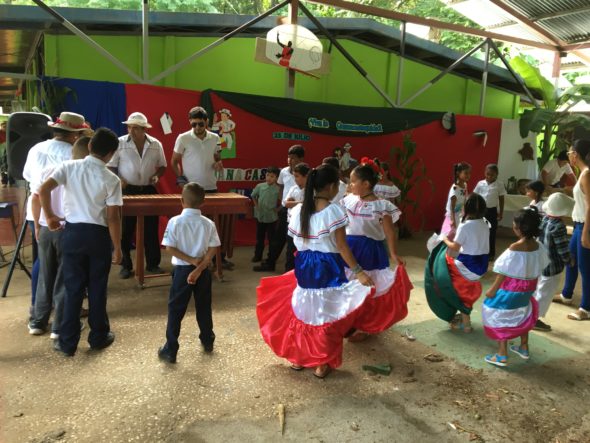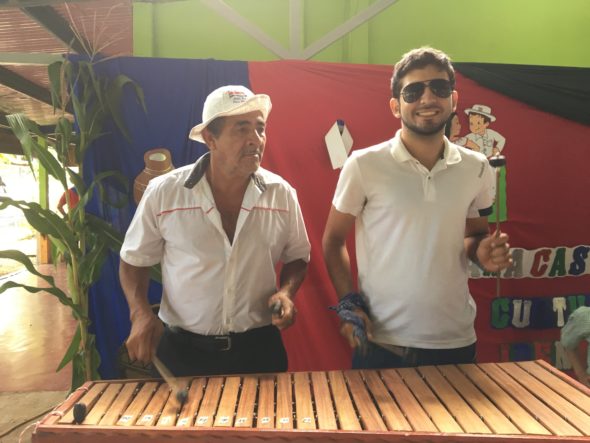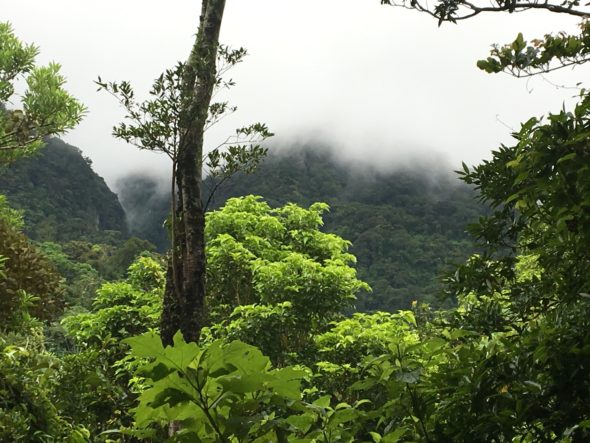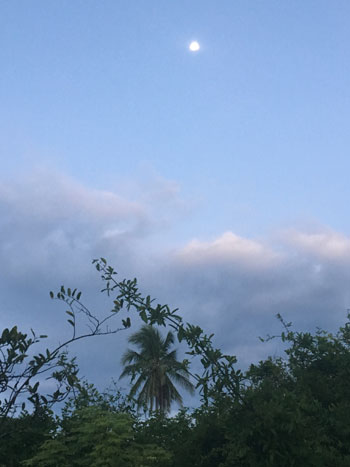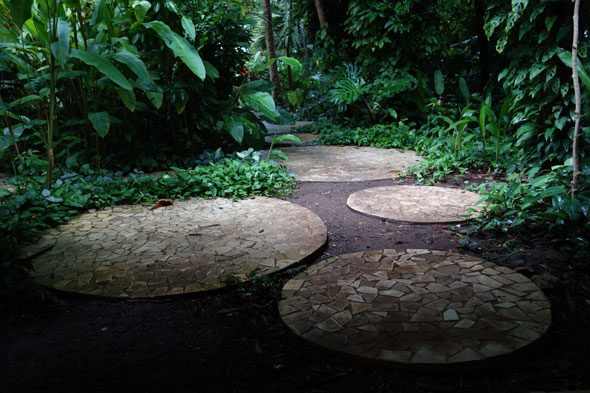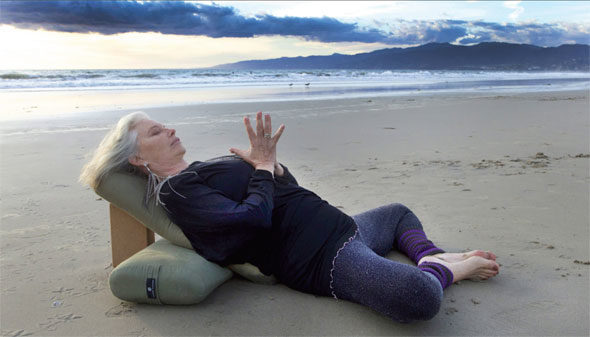
If you love restorative yoga at Harmony, you will almost certainly know Jane Fryer. Her Tuesday-afternoon classes are packed to the rafters. Attendees fit their mats into every available square foot of floor space and a devotional silence fills the room.
It’s not hard to understand why. Fryer’s gentle practice of moving the body into cushion-supported poses works to promote physical rest and renewal, while her spoken instructions are meditations geared toward quieting the mind. She doesn’t stop at ‘relax,’ however. Her deeper insights into the nature of stillness urge us further, toward ancient mystical tradition – as do her occasional invocations of the sacred feminine, which are central to her way of seeing.
I spoke to Jane in March about her practice, awakening and the connection between spirituality and feminism. Here’s our edited conversation.
Where were you before Nosara?
I was born in Washington, D.C. I travelled around the world a lot. I first came to Nosara in 1995 to visit my friends Don and Amba Stapleton who started the Nosara Yoga Institute, which just closed after 23 years. They kind of created Nosara, brought in so many students from around the world. In the 70s, all three of us were studying with the same Indian yoga guru, Yogi Amrit Desai. In the day, we called ourselves guru brothers and sisters.
Was all this hard to explain to your friends back in America then, before ‘yoga’ was a well-known word?
I couldn’t get a date! After the ashram, I was trying to reintegrate back into urban east coast culture. The type of people I was attracted to were always more conventional. I grew up in a very conventional kind of upper-middle-class American blue-blood situation.
On that first trip, we bought land. I moved here with my ex-husband in 2007. I was on the faculty (at Nosara Yoga Institute), which was a tremendous honour and a profound shift in my life. The opportunity to teach teachers was such a blessing, so stimulating and rewarding.
What did you feel that yoga was offering people like yourself?
For me, my initial experience with yoga was dropping the mind – my mind, a mind. It was in a community centre (yoga class) in Georgetown while in stressful grad school. After that initial experience, I wanted to turn other people on to it. I was enrolled in a graduate program in Women’s Studies and film production at American University and George Washington University. This was when the first Women’s Studies programs were offered – there were only four in the country. I got kicked out of the (film) program for being a feminist. Men in those days really felt attacked. Early feminist rhetoric was brutal, take-no-prisoners. I was constantly correcting everyone’s grammar. In any movement, in the beginning of it, it’s not balanced.
You emphasize yoga’s sacred feminine in your teaching. Wasn’t yoga originally designed to be practiced by men?
Primarily. The original classical yoga was very male-oriented. The philosophy is very disciplined and focused on the “nons.” Non-attachment, non-this, non-that. The tantrika tradition is about receiving the fullness and grace of life, which is very feminine.
But it was originally more ascetic.
Patanjali was the guy who wrote the sutras. They would have been the yoga bible. The point of the asanas originally was to develop the focus to sit in meditation and transcend the body. And prepare for death.
The tantric tradition, which is my tradition now, evolved in southern India, where life was good. There was fruit on the trees, fish in the oceans; the weather was good, sex was good. It had more female adherents. The goddess was equal. One of my teachers put it this way: She doesn’t need him, but he needs her because she beats his heart. Shiva and Shakti, that existed in the original scriptures and everything, but it was all about Shiva because it was all about transcending – transformation through transcendence of the body. The body was the temple, you keep it clean, you stretch it, you meditate in a cave.
My experience of (yoga) is more an embodied philosophy of active connection to everything than limited to an asana practice, or mediation practice.
I notice that in your relaxation class, you drop in a lot of ideas. You say, “Your breath is Shakti.” If the breath is female, what is the male principle?
Shiva is, in this context, our spiritual muscle – the capacity to focus on the light of awareness. Key word here is focus. Shiva’s mythology includes the ascetic, who just wants to meditate on top of a mountain, or in a Himalayan cave beyond culture. He is depicted with a blue throat. This is where he drinks the poison, but does not swallow. So, he engages fully with life, but is mindful and discriminating. Think of the “man cave,” where men need to go for regeneration and perspective. The masculine in all of us needs this. St. Francis of Assisi put it this way: “The one you are looking for is the one who is looking.” I am sure this sounded more poetic in Italian!
The merger of Shiva and Shakti, the sacred union within us, opens a portal to the Witness, where we are able to have moments of spacious direct perception. Unlimited, numinous, eternal. That’s in us.
Our nervous systems are wired to access this. In the West we call it “rest and digest”, first coined by Herbert Benson at Harvard decades ago. Now the cutting edge of all this is called interpersonal neurobiology. I could go on and on. Such exciting times, when the scientific and the esoteric are merging.
Do you teach kundalini yoga?
All yoga is kundalini yoga. Yogi Bhajan teaches that it’s a very awesome direct path. Childbirth can be kundalini yoga. It all is. It’s all geared toward awakening the chakras. It’s all geared toward awakening the sacred marriage (of male and female, Shiva and Shakti).
If one wanted to accelerate this kind of awakening in their practice – this sacred union of energies – are there ways to do that?
What I love most about yoga, if possible to say that, is it is experiential. Everyone has a unique experience within yoga. Yoga means “union.” It’s all of it, it’s all of life. The awakening that comes, the union that comes internally is not so predictable. It’s part of the mystery. If you have a conscious heterosexual couple who intentionally ignite and support the sacred marriage, yes, that will probably facilitate your experience exponentially.
None of my partners have been capable in that way. I once met a man at Esalen, who was married, who wanted to explore this. Why would I do that? I share my energy with you, and you go back to your marriage all juiced up, and I get….what, exactly? I don’t think so.
That’s so typical.
Right? <laughs>
Are there ways for homosexual couples to access that same awakening? Considering we all have Shiva and Shakti within us…
My intuitive answer to that is yes.
Do you think our culture could use more of a feminine perspective?
That’s a very gentle question. My answer to that would be we’re on the edge of extinction unless there’s a radical and urgent blooming of feminine influence and values globally. Feminism is not in a good place in this particular moment in the U.S. There’s been no progress in the last 50 years. After tremendous progress during the time of John F. Kennedy…the women who broke the glass ceiling all played a very male game.
Everything is unbalanced toward the masculine energy. Sometimes I think women have more challenges because we’re good at multitasking. We’re holding it all and thinking it’s our responsibility to make progress on everything all the time. Which is basically insane.
Do you think that yoga could almost get the feminine in through a back door – through our bodies, rather than through arguments and debates about rights and equality?
It’s important to stay optimistic. It’s imperative.
My transition from this grad school thing to this yoga lifestyle was a radical shift into believing that transformed individuals make a transformed world. But here’s the thing – how many people are willing to transform it? Transcend the world, fine. Integrating that consistently so that the tough, tough passages where we die to ourselves and become a chrysalis, not knowing who we are and where we’re going – very few people have the courage to do that. Or the calling. Certainly, in a place like Nosara there people who are called to their own potential for transformation. It is a magnet for people called to “do the work.” It is an escape for the tourists who sustain our economy. But so many of them want to come back – to do the work. Change their lives.
As I observe and support people going into full-blown transformation, I’ve come to see the value to the collective in these individual sacrifices. Letting go of one’s identity and purpose in life and still being alive – it’s like Persephone’s journey into the underworld. And that’s a feminine journey.
That’s funny, because often when we picture these ultra-transcended meditators, they’re men.
Well, I wonder how those meditators do in the “chop wood, carry water” department. Which is the realm of the feminine. I’m not dissing people in any way who sit for a lifetime. They’re creating a container that’s also urgently needed.
Transformation is a really sticky wicket. How are you going to define transformation? These friends of mine who started the Nosara Yoga Institute had this Cycle of Transformation. It had five different stages. One is The Fertile Void. That is where I guide people in restoratives.
That’s where you guide people on Tuesday afternoons.
Yes. When you drop in at the end of the exhale, there’s a stillness. The still point at the end of the exhale is a portal to the infinite. The infinite holds the space between the worlds. Between all worlds. That exploration is the path of the mystic. Multi-dimensional place. The comingling of Shakti and Shiva. But you don’t get there without the focus. Without Shiva. It’s where focus and breath meet.
Oh. Wow. I’ve never heard it explained that way before.
Well, how many people are interested in the mystic path? Not many. But everyone wants peace of mind.
Restorative practice is one way to embody our multidimensional selves and luxuriate in the radiant light within. Meditation is another practice that gets us there/here.
I think that’s a perfect last thought to end on. Thank you so much for sharing your thoughts.
